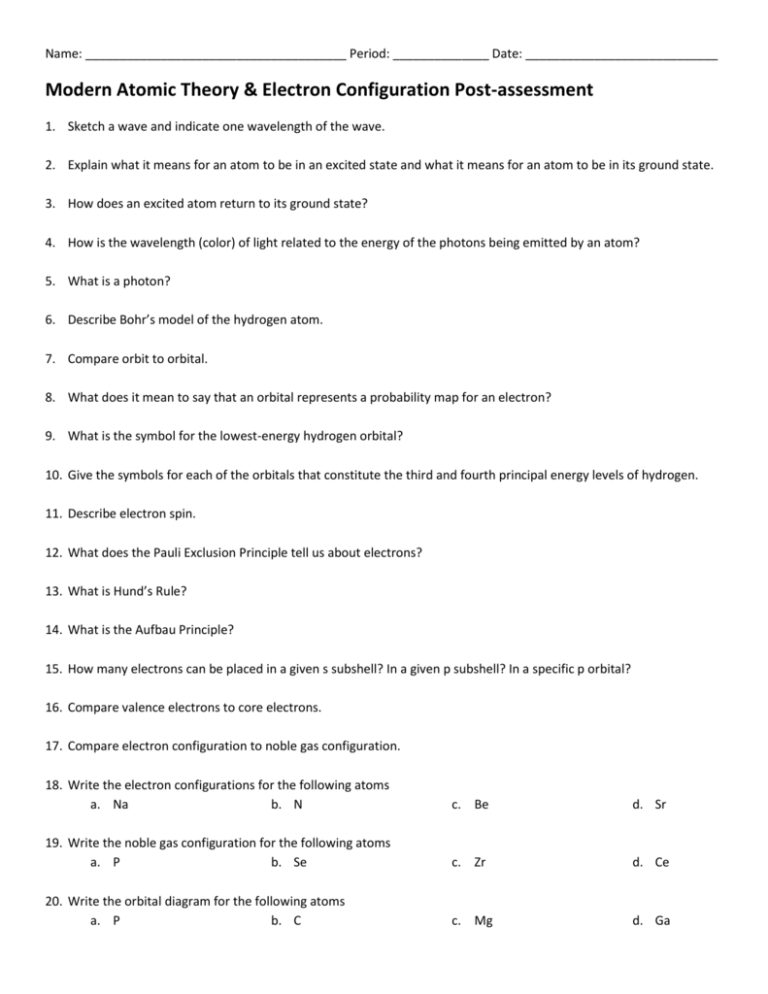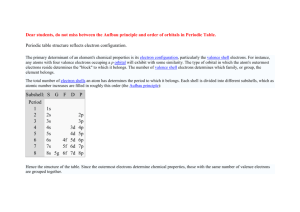Modern Atomic Theory & Electron Configuration Post
advertisement

Name: ______________________________________ Period: ______________ Date: ____________________________ Modern Atomic Theory & Electron Configuration Post-assessment 1. Sketch a wave and indicate one wavelength of the wave. 2. Explain what it means for an atom to be in an excited state and what it means for an atom to be in its ground state. 3. How does an excited atom return to its ground state? 4. How is the wavelength (color) of light related to the energy of the photons being emitted by an atom? 5. What is a photon? 6. Describe Bohr’s model of the hydrogen atom. 7. Compare orbit to orbital. 8. What does it mean to say that an orbital represents a probability map for an electron? 9. What is the symbol for the lowest-energy hydrogen orbital? 10. Give the symbols for each of the orbitals that constitute the third and fourth principal energy levels of hydrogen. 11. Describe electron spin. 12. What does the Pauli Exclusion Principle tell us about electrons? 13. What is Hund’s Rule? 14. What is the Aufbau Principle? 15. How many electrons can be placed in a given s subshell? In a given p subshell? In a specific p orbital? 16. Compare valence electrons to core electrons. 17. Compare electron configuration to noble gas configuration. 18. Write the electron configurations for the following atoms a. Na b. N c. Be d. Sr 19. Write the noble gas configuration for the following atoms a. P b. Se c. Zr d. Ce 20. Write the orbital diagram for the following atoms a. P b. C c. Mg d. Ga 21. How is the number of valence electrons in an atom related to the atom’s position on the periodic table? 22. How many electrons can be contained in all of the orbitals with a principal energy level of 3? a. 8 b. 10 c. 18 d. 32 23. In general, the rows on the periodic table correspond to _____ and the columns numbered 1A, 2A, … 8A correspond to _____. a. The orbital of the valence electrons; the number of total electrons b. The energy level of the valence electrons; the number of valence electrons c. The energy level for the core electrons; the orbital of the valence electrons d. The number of valence electrons; the energy level of the valence electrons 24. An orbital is best described as a. The pathway for an electron b. A region of probability of finding an electron c. The space in which only valence electrons exist d. A physical structure which holds the electrons 25. Write the expected electron configuration for the ground state of iron. 26. Fill in the following orbital diagram for a ground state oxygen atom. _____ _____ _____ _____ _____ _____ 1s 2s 2p 3s 27. Fill in the following orbital diagram for a boron atom in an excited state. _____ _____ _____ 3p _____ _____ _____ _____ _____ 1s 2s 2p 28. Which of the following is a representation of a p orbital? _____ 3s _____ _____ _____ 3p a. b. 29. Complete the Bohr model for Fluorine. c. 30. Complete the Bohr model for Silicon. d.





